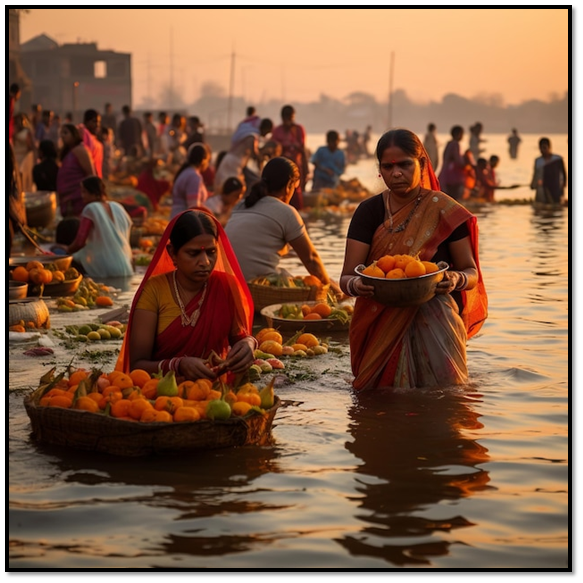Chhath Puja: A Celebration of Faith and Nature
Chhath Puja is an ancient Hindu festival with roots tracing back to the Vedic period, celebrated primarily in Bihar, Jharkhand, and eastern Uttar Pradesh, as well as in parts of Nepal and among the Indian diaspora worldwide. Observed six days after Diwali, this festival is dedicated to the worship of the Sun God, Surya, and his sister, Chhathi Maiya. Its historical significance is intertwined with various mythological stories, making it a rich tapestry of cultural heritage.

Chhath Puja is steeped in legends from Hindu epics:
- Rama and Sita: After their return to Ayodhya, Lord Rama and Goddess Sita performed a fast and worshipped the Sun God on the sixth day of Kartik Shukla, thereby establishing the tradition of Chhath.
- Draupadi: In the Mahabharata, Draupadi observed a fast and sought blessings from the Sun God, guided by sage Dhaumya, to ensure the well-being of her family.
- Karna: Some narratives credit Karna, the valiant king of Anga Desh, as the originator of the festival, emphasizing the cultural and historical depth of Chhath.
- Chhathi Maiya: Revered as the sister of Surya and daughter of Lord Brahma, Chhathi Maiya symbolizes fertility, well-being, and protection, adding a maternal aspect to the festival’s spiritual significance.
The term “Chhath” derives from the Sanskrit word “Shashthi,” meaning “sixth,” referring to its celebration on the sixth day after Diwali. The festival spans four days, during which devotees engage in rigorous rituals, fasting, and prayers aimed at attaining prosperity and health for their families. Women, in particular, observe strict fasts, often without water, demonstrating their devotion and self-discipline.
The rituals include:
- Holy Bathing: Devotees cleanse themselves in sacred rivers or ponds, symbolizing spiritual purification and renewal.
- Offering Prasad: Traditional offerings such as kheer (made from jaggery) and roti are prepared and distributed among family and friends, embodying the spirit of sharing and community.
- Arghya to the Sun: On the main day of Chhath, devotees gather at sunrise by riverbanks or ponds to offer Arghya to the rising sun, expressing gratitude and seeking blessings for health and prosperity.
Chhath Puja emphasizes the intrinsic connection between humanity and nature. It showcases reverence for the Sun, which is viewed as the giver of life and energy. This festival serves as a reminder of the importance of nature in our lives, encouraging a sense of gratitude towards the elements that sustain us.
Struggle for Justice in South Africa
Gandhi’s initial involvement in social justice began in South Africa, where he encountered severe racial discrimination. It was here that he developed his philosophy of Satyagraha—a term he coined, meaning “truth force” or “soul force.” This philosophy was rooted in the belief that nonviolent resistance could lead to social and political change. His work in South Africa was a precursor to the larger struggle for independence that he would later lead in India.


The celebration fosters community bonding, as families and neighbours come together to perform rituals, sing traditional songs, and celebrate the spirit of unity. It is a time for introspection, where devotees reflect on their lives and seek spiritual growth. The festival also symbolizes purity, self-discipline, and devotion, qualities highly regarded in Hindu philosophy.
Chhath Puja is more than just a festival; it embodies the faith, traditions, and cultural heritage of those who celebrate it. It is a poignant reminder of the values of gratitude, respect for nature, and the importance of familial bonds. As this vibrant festival continues to thrive, it enriches the spiritual lives of millions, serving as a bridge between past traditions and contemporary practices. In essence, Chhath Puja stands as a testament to the enduring spirit of Hinduism and its deep-rooted connection with the natural world
By: Chandra Kishor Jha (Senior Customer Service Executive – Delhi)




